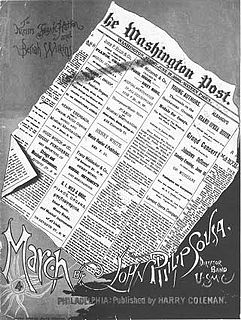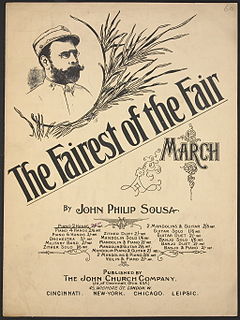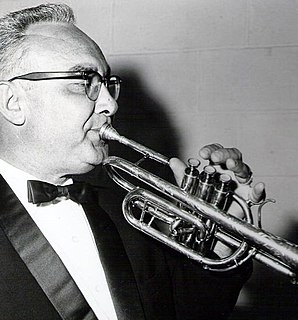
John Philip Sousa was an American composer and conductor of the late Romantic era known primarily for American military marches. He is known as "The March King" or the "American March King", to distinguish him from his British counterpart Kenneth J. Alford. Among his best-known marches are "The Stars and Stripes Forever", "Semper Fidelis", "The Liberty Bell", "The Thunderer", and "The Washington Post".

American march music is march music written and/or performed in the United States. Its origins are those of European composers borrowing from the military music of the Ottoman Empire in place there from the 16th century. The American genre developed after the British model during the colonial and Revolutionary periods, then later as military ceremonials and for civilian entertainment events.
"The Liberty Bell" (1893) is an American military march composed by John Philip Sousa.

A concert band, variously also called a wind ensemble, symphonic band, wind symphony, wind orchestra, wind band, symphonic winds, symphony band, or symphonic wind ensemble, is a performing ensemble consisting of members of the woodwind, brass, and percussion families of instruments, and occasionally including the double bass or bass guitar. On rare occasions, additional non-traditional instruments may be added to such ensembles such as piano, harp, synthesizer, or electric guitar.

"The Stars and Stripes Forever" is a patriotic American march written and composed by John Philip Sousa. By a 1987 act of the U.S. Congress, it is the official National March of the United States of America.

"The Washington Post" is a march composed by John Philip Sousa in 1889. Since then, it has remained as one of his most popular marches throughout the United States and many other countries.

Frederick Fennell was an internationally recognized conductor and one of the primary figures in promoting the Eastman Wind Ensemble as a performing group. He was also influential as a band pedagogue, and greatly affected the field of music education in the US and abroad. In Fennell's New York Times obituary, colleague Jerry F. Junkin was quoted as saying "He was arguably the most famous band conductor since John Philip Sousa."

"The Fairest of the Fair" is a 1908 march by John Philip Sousa. One of Sousa's more melodic, less military marches, it was composed for the annual Boston Food Fair of 1908. It is claimed that the memory of a pretty girl he had seen at an earlier fair inspired the composition.
The Eastman Wind Ensemble was founded by Frederick Fennell at the Eastman School of Music in 1952. It is often credited with helping re-define the performance of wind band music. At the time, concert bands used all their players for every piece, regardless of whether the composer had written a part for that instrument. If there was no part for an instrument you had in the band - for example, a contrabass clarinet or a string bass - the conductor or the publisher would have an arranger add one. Or you would simply have that instrument double another instrument - the string bass could play the tuba part, for instance. Also, bigger was better, and even though there would normally be three clarinet parts, many university concert bands would have 20 or 30 clarinets, or more.

"National Emblem", also known as the National Emblem March, is a U.S. march composed in 1902 and published in 1906 by Edwin Eugene Bagley. It is a standard of the U.S. march repertoire, appearing in eleven published editions. The U.S. military uses the trio section as ceremonial music for the entry of the ceremony's official party.

Herbert Lincoln Clarke was an American cornetist, feature soloist, bandmaster, and composer. He is considered the most prominent cornetist of his time.

The Marching Illini (MI) is the marching band of the University of Illinois Urbana-Champaign. The Marching Illini is an organization which annually includes approximately 375 students enrolled in the University of Illinois. Part of the College of Fine and Applied Arts and the School of Music, the Marching Illini represent virtually every college, discipline, and major on the University's diverse Urbana-Champaign campus.

The Dallas Winds is a professional concert band based in Dallas, Texas (USA).

Albert Austin Harding was the first Director of Bands at the University of Illinois and the first band director at an American university to hold a position of full professorship. The Harding Band Building, the first dedicated building for a University Band Department, was named for him.
The Salt Lake Symphonic Winds is a community concert band in Salt Lake City, Utah that plays contemporary band music. Its membership consists largely of music educators and amateur musicians throughout the Wasatch Front and Cache County, Utah.
Washington Grays is an American march composed by Claudio S. Grafulla in 1861. It is a mainstay of both the parade and concert band march repertoire.
The Northshore Concert Band (NCB) is a 100-member concert band based in Evanston, Illinois which performs throughout the Chicago metropolitan area.
Walter Bowman Rogers was an American cornet player, concert band and orchestral conductor and composer, who was responsible for most of the orchestral arrangements on recordings made for the Victor Talking Machine Company between 1904 and 1916.
Frank Bencriscutto, nicknamed "Dr. Ben," was an American conductor and composer of concert band music. Bencriscutto was Director of Bands and Professor of Music at the University of Minnesota for thirty-two years.

James Francis Burke was an American cornet soloist. He was the principal cornet soloist with the Goldman Band from 1943 to 1974. He was also the principal trumpet with The Baltimore Symphony Orchestra from 1943 to 1949. Mr. Burke, who had the use of only one arm, was considered the greatest virtuoso of his time on the instrument, according to Ainslee Cox, conductor of the Guggenheim Memorial Band.














